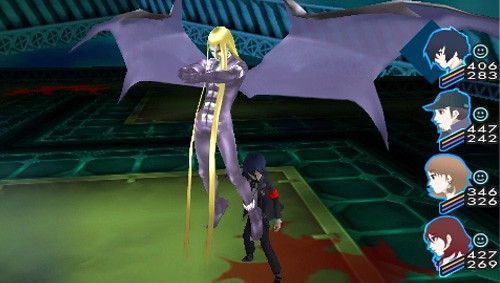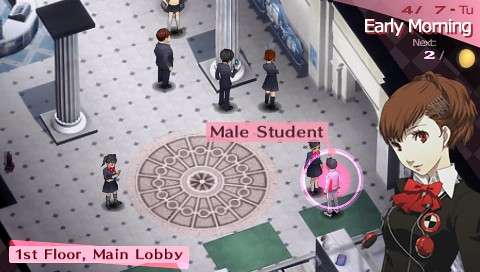The story of Persona 3 revolves around the player, playing as a student in high school in Japan, who is attacked by a being called a 'Shadow' that tries to essentially eat him/her. The player then awakens his/her own Persona that battles alongside the player to defeat the shadow. Upon the climax of the battle, a team of students named SEES who fight shadows during the dark hour, a time period between midnight and 12:01 when the shadows come out, asks you to join in their fight. The player joins and fights through the tower of Tartarus, where shadows breed and typically stay. The story has it's quirks and is fairly in depth, balancing the more serious tones of the battle with the shadows with the more light hearted details of daily high school life in Japan. On the PSP, the story is presented with Character Cut outs and dialog which is sometimes followed by voice over. Though this style is effective, compared to the killer anime cut scenes from the PS2 version I have seen online, they fall a little flat. It's easy to lose concentration on some of the more finer details simply because they not all the scenes are as engaging.
 |
| Loki: One of the Many Bad Ass Monsters to use in Battle. |
At the end of battle, periodically a shuffle time will appear. These cards start with small batches of two and eventually grow to batches of 6 or 7. Each card represents an action. Cards with swords will earn the player weapons. Cards with leaves yield the player extra experience. Cards with coins yield the player money. Cards with cups yield the player restored HP for the player or the party. And finally, cards with persona yield the pictured persona. This part will play a major role on the player through out the entire game, since in order to create you need to collect first. These persona will be useful in creating, but creating persona can yield more bonuses than capturing, and it gets pretty random as to what the player will obtain.
Creating is done in the Velvet Room by Igor and his assistant Elizabeth. When creating, the player must fuse at least two personas together, though eventually the ability to fuse up to six persona will become available to the player. The player must be at the same level that the fusion result is in order to obtain the persona, and since leveling up can take some time, this aspect makes fusing slow, but very rewarding. Very rarely will you get to a higher level fusion and regret the grinding to get there. Fusing is also built on social links. Each persona is linked to a tarot that is in turn linked to a social link (which I will get to shortly). The higher the level the social link, the more bonus experience the result persona gets after creation. By the time the player reaches level ten on a social link, the persona can go up 6 or 7 levels easily, which really adds a sense of urgency to these social links. In order to obtain the highest level personas of the tarots, the player must max out the social links.
Social links are relationships the character develops through out the game. Each social link is set to a tarot card, such as Death or Lovers, and corresponds with the persona of that tarot. Most social links can be found by talking to the right people at the right time. Upon creating the link, the player must continue to talk and meet with the person, who has a schedule to attend to as well. When the game starts out, these meetings are fairly easy to attend to, but as the amount of social links increases, it can become extremely hard to keep up with, especially when the storyline keeps the player from interacting during the day. This aspect is challenging, but extremely fun once you get used to it. The social links add more layers to the story line than I originally expected, specifically because all the characters involved have incredible depth and story lines. Not a one of the characters seems shallow or their problems trivial or archaic and it adds a great dynamic to the story telling and are really refreshing to indulge in while playing.
 |
| A Quick Shot from the new Female Student Storyline added to the Portable Version. |
The high school aspects and battle aspects are intertwined with each other, building on one another to help build the main character by the player. Battles are engaging and will feel right at home for RPG aficionados. The main character is the only player who is able to switch out personas to use in battle. Inside battle, the player can utilize skills of one persona at a time, even being able to switch to another once a turn. The experience earned in battle goes to both the player and the current persona equipped, though there are some abilities to let side lined personas earn experience as well. After battle. These battles are turn based, and commands are selected from a wheel menu, including attack, defend, abilities, commands, personas and run. The player can choose to utilize the AI for his/her companions, which worked well, but I personally like issuing all commands to all characters (which was apparently not an option in the original version). Four players are available per battle, and only those who battle will obtain experience, which can get a little frustrating later in the game when you select a main team and then lose the person for a brief time due to the story line. Each other character has their own personas that gain experience and reflect the weaknesses and strengths of that particular character, much like the main character's persona.
Graphically, the game ran smoothly with no frame rate issues. The cut outs are fantastic anime styled and the voice work when used was fantastic. The music choice, though not particularly something I have heard, was very unique and worked well with the dynamic of the game.
I personally am 65 hours into the game and haven't beaten it yet, which is amazing for me. I beat Final Fantasy XII in 62 hours and I thought that was long! This game has a lot of game play for the buck which is amazing. I highly recommend this for any one who is a fan of RPG's and has never played it. If you have already traversed Tartarus, it might be worth your while to play through the new Female version and add this game to your portable collection.
9 out of 10
Interesting Sites:
The Game's Official Site: http://www.atlus.com/p3p/
The Wiki Page: http://en.wikipedia.org/wiki/Shin_Megami_Tensei:_Persona_3
The GameFaqs (A Must Have): http://www.gamefaqs.com/psp/971508-shin-megami-tensei-persona-3-portable
The IGN Review: http://psp.ign.com/articles/110/1104053p1.html

No comments:
Post a Comment